In 1891, the Société des Gens de Lettres de France (SGDLF), a writers' association founded by the French authors Victor Hugo, Honore de Balzac, George Sand, and Alexandre Dumas, commissioned Auguste Rodin with the sculpture dedicated to Balzac.
The SGDLF considered four artists for the work prior to having appointed Balzac including Henri Chapu, Marquet de Vasselot (who made a bust of the novelist), Coutan and Millet. However, Chapu died before finalizing his work and Zola, the President of the Société, approved Rodin's application for the sculpture. The artist proposed to make a 3-meter statue within 18 months. But, the work actually took 7 years to finish.
In 1898, the plaster model was heavily criticized upon display at a Salon in Champ de Mars, and the Société rejected it. The artist felt personally attacked by criticism such as the sculpture being grotesque or comparison with the work of Medardo Rosso, an Italian impressionist. Rodin rejected all bids for his sculpture and moved it to his house in Meudon. However, 22 years after the sculptor's death, the bronze cast model was moved to the Boulevard du Montparnasse.
The Supremacy of the Monument
The Monument to Balzac is a metaphor for power and brutality, as the artist sought to underline the persona of Balzac rather than the novelist's physical appearance. It's the portrait of a conflicted writer. The dynamics with light, the subtle action, and vitality of the sculpture show Rodin's signature techniques. He breaks the monotony of traditional sculptures and makes the first steps towards contemporary art.
Rodin emphasized that the work was the sum of his entire life and the mainspring of my aesthetic theory. Being inspired by the power and grandeur of ancient Roman and Greek sculpture, Rodin's aim was to reveal power in its true form. To fully contour Balzac's status as an artist, Rodin studied him thoroughly. He made sketches from each portrait of Balzac and even had a suit made from Balzac's tailor with the artist's measurements.
The look and pose of the sculpture lead towards imagining the milieu in which the novelist lived, as Rodin himself said. Balzac's robe was criticized as being appalling, a side of beef or Balzac in a hospital gown at the first exhibit in 1898. However, Rodin knew very well that Balzac used to wear a monk's robe when he was writing. Today, this statue which is unique in depth and power is appreciated as a tribute to the great French artist Balzac. It shows the close relationship between art technique and the inner battle of artists.




